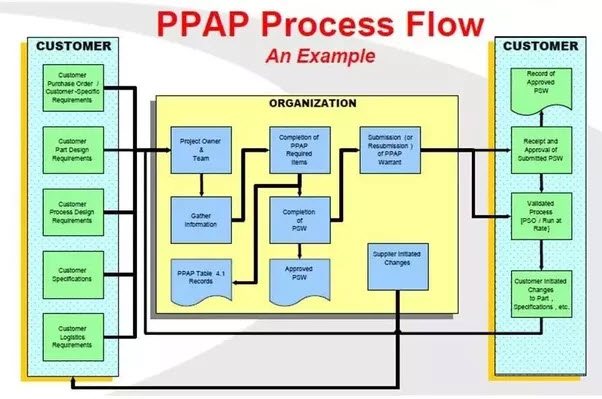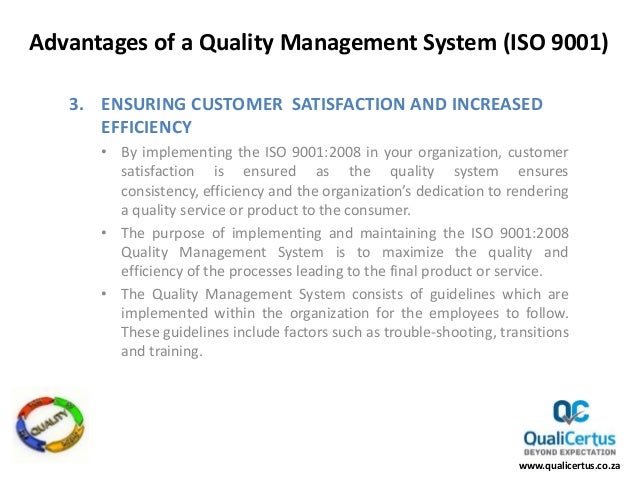01
апр
ISO 9000 certification and its’ effects on overall financial performance of the certified firm. The focus is on Greek companies. The findings are based on the latest version of the ISO series (2000), which is generally accepted as it has diminished most of the disadvantages of the previous (1994) version.
Implementing can help ensure that customers get consistent, high-quality products and services, which in turn can benefit your organization. The following ISO 9001:2015 case studies offer a look at the difference ISO 9001 can make for organizations in terms of process performance, customer satisfaction, and the bottom line. Please note: These case studies are provided as examples of how companies have improved using ISO 9001. None of these case studies used the most recent version of the standard, ISO 9001:2015, which was released in September 2015.

ISO 9001 Case Studies Learn about a project that used an ISO 9001 approach to solidify the supply chain that provides life-saving drugs to Kenyans living with HIV/AIDS. Learn how Medical Metrics Inc. Implemented an integrated management system and added ISO 9001 to a quality management system that had been structured to meet FDA regulations. A manufacturer of domes and free-style structures attributes its fast track to ISO 9001:2008 certification to its use of a wiki to document its quality management system.
See how Orkin’s internal audit process fosters more reliable service and reduces customer churn. Adopting ISO 9001 compliance as a sourcing criterion in supplier selection and requiring suppliers’ quality management representatives to become have saved the Air Force millions of dollars. Clark County School District, the largest school district in America to be ISO 9001:2000 certified, accommodated a rapidly expanding student population while achieving $174 million in cost avoidance and cost savings over 10 years. What’s Your Story?
Do you have results to share?

Fifa manager 14 editor database download. Photo by: contact ISO 9000 is a set of international standards of quality management that have become increasingly popular for large and small companies alike. 'ISO is grounded on the 'conformance to specification' definition of quality, ' wrote Francis Buttle in the International Journal of Quality and Reliability Management. 'The standards specify how management operations shall be conducted. ISO 9000's purpose is to ensure that suppliers design, create, and deliver products and services which meet predetermined standards; in other words, its goal is to prevent non-conformity.'
Used by both manufacturing and service firms, ISO 9000 had been adopted by more than 100 nations as their national quality management/quality assurance standard by the end of 1997. This quality standard was first introduced in 1987 by the International Organization for Standards (ISO) in hopes of establishing an international definition of the essential characteristics and language of a quality system for all businesses, irrespective of industry or geographic location. Initially, it was used almost exclusively by large companies, but by the mid-1990s, increasing numbers of small-and mid-sized companies had embraced ISO 9000 as well.
In fact, small and moderate-sized companies account for much of the growth in ISO 9000 registration over the past several years. The total number of ISO 9000 registrations in the United States increased from a little more than 2, 200 in 1993 to more than 17, 000 in 1998; of those 17, 000 registrations, nearly 60 percent were held by companies with annual sales of $100 million or less. The increased involvement of small and midsized firms in seeking ISO 9000 registration is generally attributed to several factors. Many small businesses have decided to seek ISO 9000 certification because of their corporate customers, who began to insist on it as a method of ensuring that their suppliers were paying adequate attention to quality. Other small business owners, meanwhile, have pursued ISO 9000 certification in order to increase their chances of securing new business or simply as a means of improving the quality of their processes. 'The pressure for companies to become ISO 9000-certified is absolutely increasing and will continue to increase, ' predicted one management consultant in an interview with Nation's Business. 'The question many smaller companies have to ask is when, not if, they [will] get ISO 9000-registered.'

ISO 9001 Case Studies Learn about a project that used an ISO 9001 approach to solidify the supply chain that provides life-saving drugs to Kenyans living with HIV/AIDS. Learn how Medical Metrics Inc. Implemented an integrated management system and added ISO 9001 to a quality management system that had been structured to meet FDA regulations. A manufacturer of domes and free-style structures attributes its fast track to ISO 9001:2008 certification to its use of a wiki to document its quality management system.
See how Orkin’s internal audit process fosters more reliable service and reduces customer churn. Adopting ISO 9001 compliance as a sourcing criterion in supplier selection and requiring suppliers’ quality management representatives to become have saved the Air Force millions of dollars. Clark County School District, the largest school district in America to be ISO 9001:2000 certified, accommodated a rapidly expanding student population while achieving $174 million in cost avoidance and cost savings over 10 years. What’s Your Story?
Do you have results to share?

Fifa manager 14 editor database download. Photo by: contact ISO 9000 is a set of international standards of quality management that have become increasingly popular for large and small companies alike. 'ISO is grounded on the 'conformance to specification' definition of quality, ' wrote Francis Buttle in the International Journal of Quality and Reliability Management. 'The standards specify how management operations shall be conducted. ISO 9000's purpose is to ensure that suppliers design, create, and deliver products and services which meet predetermined standards; in other words, its goal is to prevent non-conformity.'
Used by both manufacturing and service firms, ISO 9000 had been adopted by more than 100 nations as their national quality management/quality assurance standard by the end of 1997. This quality standard was first introduced in 1987 by the International Organization for Standards (ISO) in hopes of establishing an international definition of the essential characteristics and language of a quality system for all businesses, irrespective of industry or geographic location. Initially, it was used almost exclusively by large companies, but by the mid-1990s, increasing numbers of small-and mid-sized companies had embraced ISO 9000 as well.
In fact, small and moderate-sized companies account for much of the growth in ISO 9000 registration over the past several years. The total number of ISO 9000 registrations in the United States increased from a little more than 2, 200 in 1993 to more than 17, 000 in 1998; of those 17, 000 registrations, nearly 60 percent were held by companies with annual sales of $100 million or less. The increased involvement of small and midsized firms in seeking ISO 9000 registration is generally attributed to several factors. Many small businesses have decided to seek ISO 9000 certification because of their corporate customers, who began to insist on it as a method of ensuring that their suppliers were paying adequate attention to quality. Other small business owners, meanwhile, have pursued ISO 9000 certification in order to increase their chances of securing new business or simply as a means of improving the quality of their processes. 'The pressure for companies to become ISO 9000-certified is absolutely increasing and will continue to increase, ' predicted one management consultant in an interview with Nation's Business. 'The question many smaller companies have to ask is when, not if, they [will] get ISO 9000-registered.'
...">Disadvantages Of Implementing Iso 9001(01.04.2019)
ISO 9001 Case Studies Learn about a project that used an ISO 9001 approach to solidify the supply chain that provides life-saving drugs to Kenyans living with HIV/AIDS. Learn how Medical Metrics Inc. Implemented an integrated management system and added ISO 9001 to a quality management system that had been structured to meet FDA regulations. A manufacturer of domes and free-style structures attributes its fast track to ISO 9001:2008 certification to its use of a wiki to document its quality management system.
See how Orkin’s internal audit process fosters more reliable service and reduces customer churn. Adopting ISO 9001 compliance as a sourcing criterion in supplier selection and requiring suppliers’ quality management representatives to become have saved the Air Force millions of dollars. Clark County School District, the largest school district in America to be ISO 9001:2000 certified, accommodated a rapidly expanding student population while achieving $174 million in cost avoidance and cost savings over 10 years. What’s Your Story?
Do you have results to share?

Fifa manager 14 editor database download. Photo by: contact ISO 9000 is a set of international standards of quality management that have become increasingly popular for large and small companies alike. 'ISO is grounded on the 'conformance to specification' definition of quality, ' wrote Francis Buttle in the International Journal of Quality and Reliability Management. 'The standards specify how management operations shall be conducted. ISO 9000's purpose is to ensure that suppliers design, create, and deliver products and services which meet predetermined standards; in other words, its goal is to prevent non-conformity.'
Used by both manufacturing and service firms, ISO 9000 had been adopted by more than 100 nations as their national quality management/quality assurance standard by the end of 1997. This quality standard was first introduced in 1987 by the International Organization for Standards (ISO) in hopes of establishing an international definition of the essential characteristics and language of a quality system for all businesses, irrespective of industry or geographic location. Initially, it was used almost exclusively by large companies, but by the mid-1990s, increasing numbers of small-and mid-sized companies had embraced ISO 9000 as well.
In fact, small and moderate-sized companies account for much of the growth in ISO 9000 registration over the past several years. The total number of ISO 9000 registrations in the United States increased from a little more than 2, 200 in 1993 to more than 17, 000 in 1998; of those 17, 000 registrations, nearly 60 percent were held by companies with annual sales of $100 million or less. The increased involvement of small and midsized firms in seeking ISO 9000 registration is generally attributed to several factors. Many small businesses have decided to seek ISO 9000 certification because of their corporate customers, who began to insist on it as a method of ensuring that their suppliers were paying adequate attention to quality. Other small business owners, meanwhile, have pursued ISO 9000 certification in order to increase their chances of securing new business or simply as a means of improving the quality of their processes. 'The pressure for companies to become ISO 9000-certified is absolutely increasing and will continue to increase, ' predicted one management consultant in an interview with Nation's Business. 'The question many smaller companies have to ask is when, not if, they [will] get ISO 9000-registered.'
...">Disadvantages Of Implementing Iso 9001(01.04.2019)